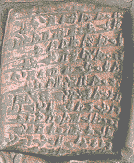
|
|
||
|
|
 |
|
|
|
||
|
The earliest writing in Mesopotamia was a picture writing invented by the Sumerians who wrote on clay tablets using long reeds. The script the Sumerians invented and handed down to the Semitic peoples who conquered Mesopotamia in later centuries, is called cuneiform, which is derived from two Latin words: cuneus , which means "wedge," and forma , which means "shape." This picture language, similar to but more abstract than Egyptian hieroglyphics, eventually developed into a syllabic alphabet under the Semites (Assyrians and Babylonians) who eventually came to dominate the area. |
| In Sumer, the original writing was pictographic ("picture writing"); individual words were represented by crude pictorial symbols that resembled in some way the object being represented, as in the Sumerian word for king, lu-gal : |

|
The first symbol pictures "gal," or "great," and the second pictures "lu," or "man." Eventually, this pictorial writing developed into a more abstract series of wedges and hooks. These wedges and hooks are the original cuneiform and represented in Sumerian entire words (this is called ideographic and the word symbols are called ideograms, which means "concept writing"); the Semites who adopted this writing, however, spoke an entirely different language, in fact, a language as different from Sumerian as English is different from Japanese. In order to adapt this foreign writing to a Semitic language, the Akkadians converted it in part to a syllabic writing system; individual signs represent entire syllables. However, in addition to syllable symbols, some cuneiform symbols are ideograms ("picture words") representing an entire word; these ideograms might also, in other contexts, be simply syllables. For instance, in Assyrian, the cuneiform for the syllable "ki" is written as follows: |

|
However, as an ideogram, this cuneiform also stands for the Assyrian word irsitu , or "earth." So reading cuneiform involves mastering a large syllabic alphabet as well as a large number of ideograms, many of them identical to syllable symbols. This complicated writing system dominated Mesopotamia until the century before the birth of Christ; the Persians greatly simplified cuneiform until it represented something closer to an alphabet. |

| The Mesopotamians wrote on clay tablets with long reeds while the clay was still wet. The fresh clay then hardened and a permanent record was created. The original Mesopotamian writings were crude pictures of the objects being named, but the difficulty of drawing on fresh clay eventually produced the wedges and hooks unique to cuneiform. This writing would be formed by laying the length of the reed along the wet clay and moving the end nearest the hand from one side to another to form the hooks. As with all cultures, writing greatly changed Mesopotamian social structure and the civilization's relationship to its own history. Writing allowed laws to be written and so to assume a static and independent character; history became more detailed and incorporated much more of local cultures' histories. Richard Hooker |

©1996, Richard Hooker
For information contact: Richard Hines
Updated 7-14-1999
...........................
Language & Writing - Cuneiform
The Sumerian language was not deciphered until the nineteenth century of our era when it was found to be different from both the Indo-European and Semitic language groups. Fifteen hundred cuneiform symbols were reduced in the next thousand years to about seven hundred, but it did not become alphabetic until about 1300 BC.
By 2500 BC libraries were established at Shuruppak and Eresh, and schools had been established to train scribes for the temple and state bureaucracies as well as to legally document contracts and business transactions.
Schools were regularly attended by the sons of the aristocracy and successful; discipline was by caning.
Sumerian, the oldest known written language in human history, was spoken in Mesopotamia (modern Iraq and peripheral regions) throughout the third millennium BC and survived as an esoteric written language until the death of the cuneiform tradition around the time of Christ.
The Sumerian language, which is related to no other known tongue, was only properly deciphered this century.
A considerable literature in Sumerian is currently being reconstructed from fragmentary clay tablets housed in the museums of the world.
A logogram is a meaningful cuneiform sign.
The most important words in Sumerian had their own cuneiform signs, whose origins were pictographic, making an intial repertoire of about a thousand signs or logograms. Sumerian was an agglutinative language not just in its verb construction, but also in its noun or morpheme construction.
Sumerian Writing

The earliest known writing comes from Uruk and has been dated to about 3,300BC. It took the form of 'word-pictures' drawn with a stylus on tablets of damp clay. Each word-picture represented an object. Much later, the complete system had more than 700 signs. Tablets measured about 5cm wide and 2cm thick.

Writing developed as a convenient way to keep records of produce and accounts of trade. It much later became used to record literature and history.
The word-pictures from Uruk developed into the script now called cuneiform. The pictures gradually became 'ideographs', an object also meaning an 'idea'. Then came 'phonograms' representing sounds as well as the meaning of a picture.
Cuneiform was a syllabic script with hundreds of wedge-shaped signs that developed from these pictures.
The Sumerians were the earliest to write in cuneiform, closely followed by the Assyrians, Babylonians, Elamites, Hittites, Hurrians and the Urartu from Anatolia.
Cuneiform was the language of politics until the fifth century BC. It died out and was replaced by the 22 letter Aramaic in about 900BC.

The earliest known documents in cuneiform were written by the Sumerians of southern Mesopotamia, who assigned their own word-sounds to the symbols.
Tools included clay tablets and a wedged shapped stylus to produce writing.

Over 200,000, many from city of Mari, have been preserved. Writing was deciphered by Sir Henry Rawlinson after finding the "Rock of Behistun" in present-day Iran.
